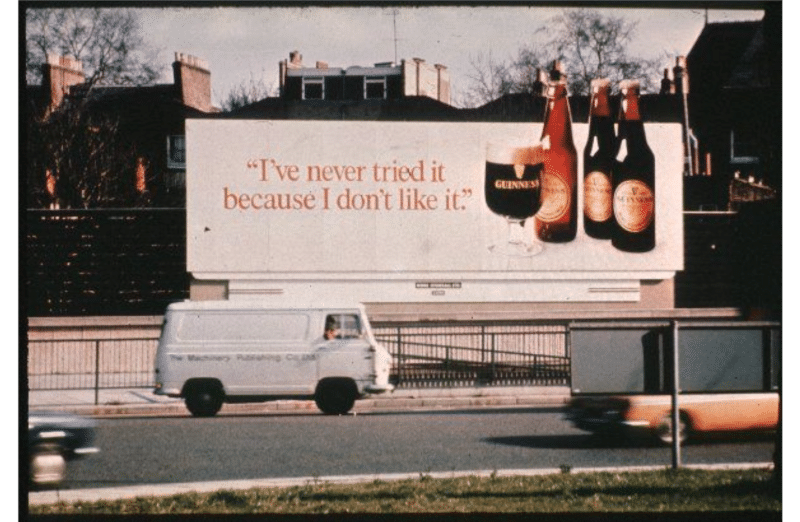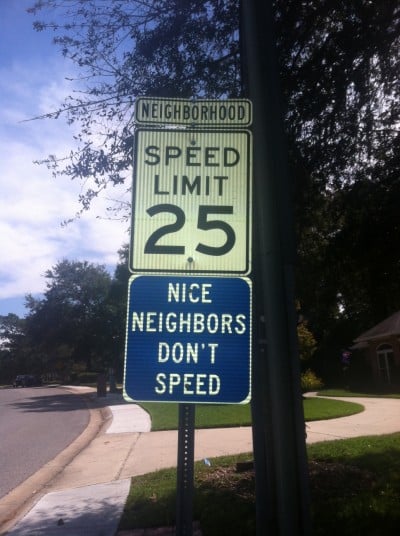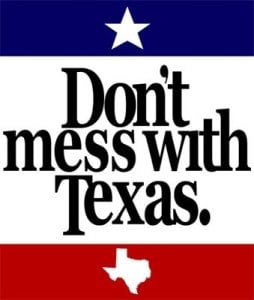Why is this billboard so absolutely brilliant?

Because lots of the people who viewed it hadn’t tried Guinness — and most of them hadn’t tried it precisely because they presumed they wouldn’t like a dark beer.
So the headline perfectly captured — and forced readers to confront — the truth about their position.
A position that went against their desired self-image as reasonable and open-minded individuals.
So something had to change.
They could either become OK with their irrationality, or they could try a Guinness on their next visit to the pub and re-affirm their identity as a reasonable and open-minded guy or gal.
Which would you prefer, in that situation?
Are You a Nice Neighbor?
Here’s another example:
 Now how much more effective do you think this sign is than a typical speed limit sign?
Now how much more effective do you think this sign is than a typical speed limit sign?
How about 100X?
Maybe that’s an exaggeration, but it’s at least an improvement measured in multiples and not percentages, right?
This is the speed limit sign posted near my kid’s elementary school.
Parents racing to get their kids dropped off on time would see that and slow down.
As opposed to racing by a standard speed limit sign.
So what’s the difference?
1) The sign labels itself as the “Neighborhood” speed limit, making it seem like a community-decided standard, rather than a government-imposed limit.
2) The text on the blue sign presents the driver with the inarguable behavioral standard of “nice neighbors don’t speed.” Forcing you to either accept that you’re not a very nice neighbor, or you need to slow the heck down.
As you can imagine, the vast majority of parents opted to retain their self-image as a nice neighbor.
Are You a Proud Texan?
Finally, there’s the most famous example of this technique:
How do you get a bunch of rebel-rousing, pick-up driving, cowboy boot-wearing, 20-something Texans to stop littering?
Well, you don’t do it by threatening them with fines or appealing to the environment.
 Neither of those approaches worked for the Texas Department of Transportation.
Neither of those approaches worked for the Texas Department of Transportation.
What did work was appealing to their self-image as proud Texans.
Because proud Texans don’t besmirch their beloved state with trash.
So the Don’t Mess With Texas campaign was launched and promptly reduced litter by 76%
Drivers could either maintain their image as proud Texans or they could continue to litter.
Do Your Ads Address Your Customer’s Self-Image?
The true root of branding is association design aimed at your customer’s self-image.
You don’t want customers making their buying decision based on consumer-reports styled “most bang for the buck” considerations.
Instead, you want them asking themselves:
What kind of person am I, and who would that person hire or trust in this situation?
And when they do ask that question, you want your brand and company to be the obvious answer.
If your branding campaign isn’t causing that to happen, then a smart business owner like yourself should find a better advertising team.
- Brands Are Small Things — And That’s a Good Thing! - April 16, 2024
- The Two Universal Appeals — Understanding the “Cult” of Cult Branding - April 9, 2024
- 6 Overlooked Truths For B2B Marketing Success - April 1, 2024
